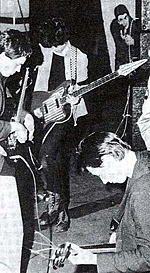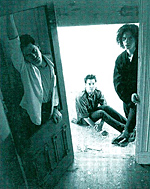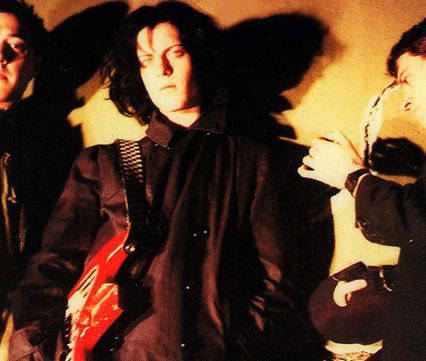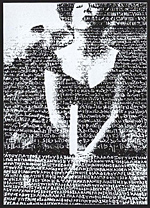
Factrix je jedan od najvažnijih preskočenih (u svoje doba) i potom zaboravljenih bendova pokojnih kasnih sedamdesetih i osamdesetih. Sa svakim novim danom njihova muzika sve je suvremenija. Cabaret Voltaire i DNA pomnoženi s Velvet Underground.
Tjeraju vas da dignete gramofonsku iglu sa svojeg života, zatvorite se u nešto zamračeno i iscrpite se neživljenjem.
I otkrijete kojeg je spola život.
X-COMMUNICATION with music by FACTRIX:
Factrix/Cazazza "California Babylon" Reissue
 |
| Factrix/Cazazza live in 1980 at Kezar Pavillion left to right: Joseph T. Jacobs, Cole Palme, Bond Bergland, Monte Cazazza, Tana Emmolo-Smith |
 Factrix were a San Francisco-based trio - featuring guitarist Bond Bergland and multi-instrumentalists Joseph T. Jacobs and Cole Palme - formed in 1978. The band seemed aesthetically sympatico with the so-called "industrial" movement spawned by Throbbing Gristle and counting amongst their peers, disparate entities like SPK and NON. Although these sorts of units seemed to spring from a firmament vaguely catalyzed by the Punk revolution, the focus of these loosely associated artists had far less to do with rock and roll tradition and more to do with mood, sonic experimentation and macabre obsessions with contemporary cults and undercurrents of violence in society. Reflecting a dour, proto-gothic sense of subject matter and minimalistic delivery, Factrix's 1981 Adolescent Records debut album "Scheintot" was a low-key affair, tossing a lot of random instrumentation and approaches into the ring. It's hard to pin down, and I believe that is exactly the point. Despite Julian Cope's hyperbolic championing of the band (and his oddly histrionic anti-No Wave jabs) in the liner notes of the brand new, beautifully mastered and packaged Superior Viaduct reissue, the album isn't particularly timeless. The opening instrumental death-boogie "Eerie Lights" opens with treated voice, Bergland's Fripp-ish tritone guitar riffing and subtle electronic shadings over a light, mechanical pulse. Nothing could possibly sound more totally "Eighties" - but, if that's what you want, here it is in all its New Wave glory! In the studio, Factrix concentrated heavily on detailed timbral collage rather than propulsion, so most of these loosely structured pieces brood and slink across the murky mise en scène languidly in a haze. The reissue appends a duo of discordant contents from a 1980 single as bonus tracks.
Factrix were a San Francisco-based trio - featuring guitarist Bond Bergland and multi-instrumentalists Joseph T. Jacobs and Cole Palme - formed in 1978. The band seemed aesthetically sympatico with the so-called "industrial" movement spawned by Throbbing Gristle and counting amongst their peers, disparate entities like SPK and NON. Although these sorts of units seemed to spring from a firmament vaguely catalyzed by the Punk revolution, the focus of these loosely associated artists had far less to do with rock and roll tradition and more to do with mood, sonic experimentation and macabre obsessions with contemporary cults and undercurrents of violence in society. Reflecting a dour, proto-gothic sense of subject matter and minimalistic delivery, Factrix's 1981 Adolescent Records debut album "Scheintot" was a low-key affair, tossing a lot of random instrumentation and approaches into the ring. It's hard to pin down, and I believe that is exactly the point. Despite Julian Cope's hyperbolic championing of the band (and his oddly histrionic anti-No Wave jabs) in the liner notes of the brand new, beautifully mastered and packaged Superior Viaduct reissue, the album isn't particularly timeless. The opening instrumental death-boogie "Eerie Lights" opens with treated voice, Bergland's Fripp-ish tritone guitar riffing and subtle electronic shadings over a light, mechanical pulse. Nothing could possibly sound more totally "Eighties" - but, if that's what you want, here it is in all its New Wave glory! In the studio, Factrix concentrated heavily on detailed timbral collage rather than propulsion, so most of these loosely structured pieces brood and slink across the murky mise en scène languidly in a haze. The reissue appends a duo of discordant contents from a 1980 single as bonus tracks.  |
| Updated artwork for "California Babylo |
 |
| Industrial Icon or Dingleberry? "PRO MAN SON" |
 |
| Titles from the Factrix/Cazazza DVD |
Factrix live eschewed their subtlety for an air of artful confrontation. The earliest released recordings by the band appeared on the "Live At Target" compilation lp, documenting a concert from February 1980. The attack is more blatantly rockish and aggressive. The 1982 "California Babylon" release is a lo-fi affair, mating the core unit with antisocial SF weirdo Monte Cazazza, with guest appearances by scrap metal stylist Z'ev and scenemaker Tana Emmolo-Smith. When I originally owned this disc, it always seemed like a big piece was missing from the puzzle - the bare audio fell short on many levels, making the LP seem like a personal archival document of something we, the listeners, were not particularly made privy to. I am happy to say that the full picture comes together here in the form of the outstanding bonus DVD of the group's mythic "Night Of The Succubus" performance video. At the time, this video was only available on VHS from some ungodly amount of money. As a result, I never met a single person who had owned or even seen it. In context, the rough, chaotic noisemaking of "California Babylon" becomes a bona fide artistic happening.
The following is a huge spoiler for the video. Stop reading now if you want to experience it yourself for the first time.
We enter a dark realm once the raw, spectral titles begin to emerge from darkness. Piercing guitar noise strafes steady, low grunts from the bass guitar on "Death By Hanging". The action opens with "Poltergeist", featuring more slobbering racket from Bergland and Jacobs. Cole Palme is in the background, attending to mysterious electronic processes. At random intervals, cryptic, strobing footage visually interrupts the performance shots. A psychedelically filtered video clip of Charles Manson introduces "Pro Man Son", featuring Monte Cazazza. Cazazza calmly recites what I believe are quotes from the notorious icon before a primitive drum machine kicks in. The camera focuses on an image of Squeaky Fromme. Stills of the Manson Family are intercut. Bergland begins yet another angular, feedback-laden tirade, lit cigarette dangling from his mouth. Cazazza pounds the strings of a bass guitar like a drum, as hard as he possibly can with his clenched fist. We see some darkly lit footage of another Factrix performance. Cole Palme sings on "Thin Line" while strumming high chords on a cheap bass. A tape of Jim Jones is played. Footage of Cazazza violently stabbing at the camera is interspersed. We see a skull as Jones screams and giggles maniacally. Macabre, primitive images of paintings from the People's Temple are flashed. Most of the band is seen hovering around electronics at the back of the stage. An atonal version of "Helter Skelter", initially riddled with massive flanging follows. At the end of the song, Cazazza, frantically tinkers with some sort of mechanical device with a yellow tank on it. Someone in the back of the stage is cutting away at paper covering something hanging from cables. The negative energy of the band's music is lethargic but insistent. More previously recorded Factrix film footage is laid over the ruckus and the Manson Family stills are shown again, as well as many other film stills including Christopher Lee as Dracula and Roman Polanski in drag in "The Tenant". Finally a skinned animal converted into a robot is seen hanging behind the performance space and violinist Tana Emmolo-Smith joins the fray. The animal/robot starts ascending across the space, shuddering as more people enter the scene. Jacobs begins using a grinder on the corpses' teeth as it nears the front of the stage. An explosion suddenly goes off. Closeups of the slimy, shuddering cyber-beast. Someone flicks off the camera before the morbid creature continues its pained, deathly journey across the performance space, into the audience. Smith throws her violin across the room and walks off. Painful feedback occurs. Minutes later, someone attacks the flesh robot with a folding chair.

Call the PC Police: You can't make this kind of art anymore. Factrix' Joseph T. Jacobs does dental surgery. http://weaselwalter.blogspot.com/2012/07/factrixcazazza-california-babylon.html

Factrix
Scheintot
Gothedelick K.O.
Travelling through the USA with The Teardrop Explodes during 1980-82, and always in a psychedelic condition, I was strongly aware through my meetings with umpteen kohl-eyed LSD-informed edge-of-towners that the more extreme elements of the W. Coast American Underground were in the process of appropriating many facets (both musically fundamental and sartorial stylistic) of the equivalent English and New York scenes; but subsuming them all into a uniquely ‘Gothadelick’ melage of their very own. And so it was that on the terrifically heatful American Pacific coast, incongruous long macs and the Germanic funk of the English Northern scene came to be conflated into the more obviously Banshee/Cureified darkness and dyed black hair of the post-punk south of England, and the wailing wall-eyed immediately-post-Blank Generation stares of arch NY so-jazz smackies, to manifest in San Francisco as groups such as Patrick Miller’s disturbing Minimal Man and Messrs. Bergland, Jacobs & Palme’s even more disturbing Factrix. Alongside such artists as Monte Cazazza and Boyd Rice, the aforementioned were responsible for creating unearthly and unexpectedly vampiric blends of A Certain Ratio’s “All Night Party” 45, Throbbing Gristle’s ‘Slugbait’, Cabaret Voltaire’s canon of Krautdub, the Detroit rock-through-an-ERASERHEAD filter of Chrome, the NO NEW YORK Do-Nuthing distorto-epic that was Mars circa “Hairwaves”, the micro-orbiting dirges of 1977/78 Pere Ubu’s “My Dark Ages”/“Chinese Radiation”/”Laughing”, etc. If the EDWARD SCISSORHANDS soundtrack had been supplied by Hollywood musos using Factrix’s SCHEINTOT LP as their blueprint, it would have created a perfect snapshot of the hairbrushed post-punk twilight zone that was the 70s/80s gateway.
 Huddled in concert
Huddled in concert Both sides of the portal
Both sides of the portalBut that weren’t nearly enough for these Poe faced kiddies, no, dear me no. These druids had to go umpteen seven-league boot strides further, and illustrate the back cover of their LP sleeve with a tomb rubbing from the back of Ralph Hamsterly’s bizarre 16th century Oxfordshire grave at the chillingly-named Doddington – ‘farm [ton] at the judgement centre [ting] of the dead [dod]’. Then they had their sinister mate Monte Cazazza (himself a twilighter supreme) set up a front cover photograph that involved a naked female friend seemingly being disrobed by a ancient skeletal hand so perished that wire was necessary to clamp them drybones together. Obviously informed by Mik Mellen’s bizarrely unfinished Cleveland industrial photographs of the mid/late 70s, this half-scene-through-a-semi-closed-door vision of their world propels the listener into a dreamlandscape somewhat akin to that sacred phantom downland conjured up on The Residents’ NOT AVAILABLE.
 Pin-ups
Pin-ups“It Was Taking Us To Some Very Dark Places”
For the creation of the ultimate possible form of Rock’n’roll music, I’ve always reckoned on needing a balance of about 65% Tradition to about 35% Novelty. In this way, your song can still be propelled along by a candy-assed cliché of a hookline that everyone reckons to have heard a zillion times before (The Traditional element), because the context in which that cliché finds itself is unbalanced enough to bring something entirely new to the party (The Novelty element). The greatest purveyors of Rock’n’roll always seem to have adhered to this formula, Suicide, Prince, Outkast being great cases in point, but The Velvet Underground still being ur-practitioners of the Ult.
However, such simplistic rules go right out of the window when addressing the so-called Experimental Music scene. Indeed, I’d probably have to go simultaneously in both of the other directions if asked to make the case for presenting The Alchemical Instruction Book for the Optymum Methodes of Reachyng Most Effectyve Experimental Musics, and say that travelling ‘all the way to 100% cliché’ is possibly even more effective than the route that follows the signpost reading ‘100% novelty’. In other words, just as Kimmy the Fowl’s OUTRAGEOUS was a spoof psychedelic Death & Resurrection Trip that still functioned as the real thing, so in the same way can true psychedelic disorientation be genuinely achieved simply by putting together a rigorous assortment of such obvious ingredients as Sabbath doom chord changes and Hammer Horror sound FX, weakshit bubbling drumboxes, portentous Lizard King proclamations, squirrly analogue ARP-ness, Brion Gysin-style early cut-up doomalogues about rotten and drowned muses; and all done whilst wearing white face, black clothes and hairstyles a la Tristan Tzara. Which is why Factrix, a trip forged entirely of slugs and snails and puppy-dogs tails can be so successful artistically AND useful psychically. Yup, even if it’s ultimately just a Pyrrhic Victory for Rock’n’roll, listening to “Horse Latitudes” as performed by autistic adolescents in Charles Manson’s boxroom is always gonna be a worthwhile exercise to your most seasoned Inner Space Traveller. Taking a look at the Factrix trio’s instrument list (and the manner in which it is described) is itself a journey through their own prolapsing minds:
BOND BERGLAND: guitars, vocals, tape treatments, viola, radioguitar, percussion, drum machine, processing, zither, teakettle
COLE PALME: vocals, glaxobass, multimoog, tape treatments, drum machine, processing, amputated bass
JOSEPH JACOBS: bass guitar, fretless bass, drum machine, vocals, tape treatments, pennywhistle, migh-wiz, saz, doumbek, flute, percussion
 Concert Poster
Concert PosterAdmittedly, SCHEINTOT is hardly the kind of LP that should be given a song-by-song description, save to say that, in context, “Ballad of the Grim Rider” sounds like a Top 10 hit merely because it has a graspable form (and don’t get me started on the Odinist imagery that pervades their entire oeuvre). But SCHEINTOT is a record that deserves to be experienced several times, preferably in the darkness and in a state of near exhaustion (and/or informed by psychoactive chemicals). Its only failure in the dark light of the early 21st century is to be a half-hour to short – and even that could be remedied by several back-to-back playings without overly wearing out the (what) hooklines. Sitting some way between Germany’s ultra playful Der Plan and Throbbing Gristle’s Gen-driven death music, the underlying heartbeating non-groove that informs all Factrix music is always a truly human one, a beeping crab skank that takes you forever two steps forward and three steps back. But if you accept the Factrix metaphor of suspended animation and give yourself to SCHEINTOT’s unyielding form, listeners will soon reach below the incurably arch vocals into a pre-temple-building nomadic (and still-glacial) nether world somewhere close to that archaic place where the Frost Giants played and the nomadic Trickster kept his prick stuffed into a box that he carried around on his back. Let me take you down, ‘cause I’m going too!
Album Discography
SCHEINTOT (1981 Adolescent)
CALIFORNIA BABYLON with Monte Cazazza (1982 Subterranean)
ARTIFACT (2003 Tesco) - Julian Cope
| FACTRIX - ScheintotArguably the most prescient band of the entire late 70's San Francisco underground, FACTRIX released just one 7-inch and two pioneering LP's in the early 80's. Formed in 1978 by Cole Palme (one-time member of the LAFMS group AIRWAY) and Bond Bergland (later of SAQQARA DOGS), the two initially called themselves MINIMAL MAN and performed a handful of shows along with Patrick Miller (who would go on to have a great solo career under the MM moniker). Soon they enlisted bassist Joseph T. Jacobs (BAY OF PIGS) and emerged from their Mission-district basement with their own unique take on the burgeoning English and New York post-punk scenes. The results were throbbing walls of damaged electronics, grim lyrical musings, droning bass, piercing guitar, and a modified Roland CR-78 played at 1/4 its slowest speed.FACTRIX's sole "studio" album, 1981's Scheintot, is a dark, moody, and penetrating work that grows more contemporary every year. Genuinely disturbing at times and often disorientating, it filters the influence of peers such as CABARET VOLTAIRE and DNA through the sonic and structural sensibilities of THE VELVET UNDERGROUND. An underappreciated masterpiece of the early industrial/No Wave era, Scheintot is a record that compels the listener to lift the needle from the run-out groove and listen again and again. Julian Cope describes it best: "FACTRIX's Scheintot deserves to be experienced several times, preferably in the darkness and in a state of near exhaustion (and/or informed by psychoactive chemicals)." This first time reissue comes from the original analog source. LP with gatefold insert. CD with 16-page booklet + "Empire of Passion b/w Splice of Life" single. Liner notes by Julian Cope. FACTRIX / CAZAZZA - California BabylonCalifornia Babylon is a far more sparse and caustic offering than FACTRIX's debut, Scheintot, documenting their live collaboration with notorious artist MONTE CAZAZZA, who along with recording for THROBBING GRISTLE's Industrial label also coined its "Industrial Music for Industrial People" motto. Originally released on the seminal Subterranean Records in 1982, California Babylon remains one of the best collections of violent guitar and primitive machine-noise resonance ever released. Featuring a musical treatment of the Brion Gysin permutation poem, "Kick That Habit Man," with avant-garde percussionist Z'EV backing the band.This first time reissue comes from the original analog source. LP with archival inserts. CD+DVD contains bonus material of four studio tracks previously unreleased in the US, the "Prescient Dreams" single, and a feature-length movie, the so-called "Night of the Succubus" (live in San Francisco 1981), complete with special appearance by Mark Pauline from SURVIVAL RESEARCH LAB |
Nema komentara:
Objavi komentar